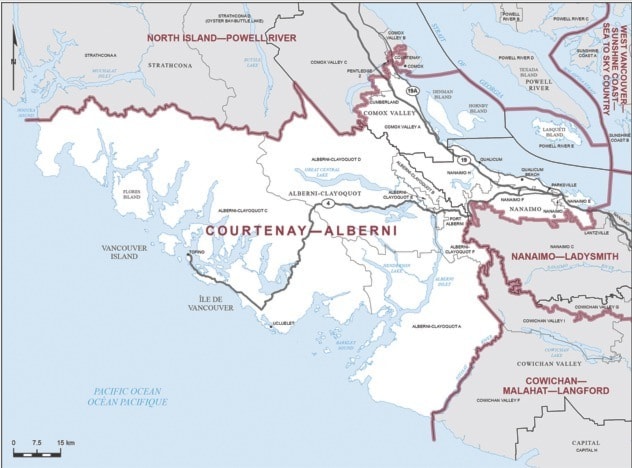A multitude of diverse communities make up the newly created federal riding of Courtenay-Alberni.
From the remote Hesquiaht in the northeast corner to the Alberni Valley in the middle of the Island to Parksville at the eastern edge, the diversity of the populations that make up the newly created riding are diverse as any across the country.
And that, according to University of Victoria associate professor of political science Dr. James Lawson, is a problem Canada-wide.
“This is a perpetual problem of a system based on geographical units because there is such a profound difference in geographical concentration between cities and rural ridings,” said Lawson.
Since each riding is supposed to have a similar number of voters in order to have similar influence in Ottawa, ridings can end up looking like “voter grab bags”—determined by population and not similarity of communities.
“So the problems you see in Port Alberni are the problems you see in a lot of rural and remote ridings,” he said.
The problem could be overcome, he added, in a variety of ways. List voting for example, has voters vote for a list of candidates and the seats are allocated to MPs based on how many votes each party gets.
A combined system is also an option, whereby voters vote both for a local candidate and then for candidates for a larger region, possibly province sized.
But while Courtenay-Alberni may be a “grab bag” of voters, the voting patterns of the people in it are unlikely to change much since the previous election.
“Election to election, regions in rural areas tend to vote in similar patterns over time,” said Lawson.
But that might be set to change.
According to Insights West, if the current riding boundaries were applied to 2011 and 2008, NDP support has grown from 34 per cent to 40 per cent while the Conservatives have held steady at 45 per cent.
The recent months have been good for the Conservative Party in Courtenay-Alberni; John Duncan has narrowed the gap between himself and NDP candidate Gord Johns to just five points. Johns remains the front runner with 30 per cent of the projected vote, while Duncan has 25 per cent according to Insights West.
The NDP have seen a dip in the polls around the country recently, said Lawson, adding that is likely due to Liberal Party announcements of increased infrastructure spending and deficits—something that typically appeals to left leaning, traditionally NDP voters.
In Courtenay-Alberni however, it isn’t the Liberals who have been buoyed by spending announcements but rather the Conservatives: funding announcements “speak to voters in a place like Port Alberni were there has been stagnation in jobs and the economy.”
What toll the longest ever federal election campaign will have on both the outcome of the election and voter turnout is yet to be determined, Lawson said.
Canada does not have rules for how long an election campaign may be—only rules that set the date.
What is determined however is the amount of funding that each party has access to—and that depends on the length of the election campaign.
“Critics [of the Conservatives] would have said that this was an attempt to make available more campaign funds,” said Lawson. The Conservatives have typically had the most monetary support from their supporters, he added.
More than the length of the campaign, Lawson believes that it’s the tightness of the race that will affect how many people turn out to the polls.
“It’s a fairly tight race,” he said.
“Relatively few votes in relatively few ridings could make the difference,” said Lawson.
That’s also given rise to organizations touting strategic voting, particularly among the non-Conservative voters.
In what could be a positive for increased turnout, Elections Canada reports that the 3.6 million votes that were cast during advanced voting days—1.2 million on Monday alone—is 71 per cent higher than advanced voter turnout in 2011. Whether that’s people turning out early instead of on election day or an added influx of new voters won’t be known till after Oct. 19.
reporter@albernivalleynews.com
twitter.com/AlberniNews
